 |
surfresearch.com.au
witzig : we're tops now, 1967
|
John Witzig : We're Tops Now, 1967.
Witzig, John: We're Tops Now
Surfer
Volume 8 Number 2 pages 46 to 53.
May 1967.
| home | catalogue | history | references | appendix |
 |
surfresearch.com.au
witzig : we're tops now, 1967
|
In hindsight,
the publication of We've Tops Now was
detrimental to Australian-Californian relations, although many
may not have read past the deliberately inflamatory title.
The editors of Surfer might had made a more
significant contribution to surfing if they had, instead,
reprinted the technically brilliant article by Bob McTavish.
On the following pages are the views of
Australian surfers presented by leading Australian surf
writer, John Witzig.
Witzig
writes of the new "power" school of Australian surfing and
says...
"We're Tops
Now"
by John Witzig- Australia.
"Nat will
thrash Nuuhiwa, and make Bigler look like a pansy."
These were
the words of Bob Cooper when he saw Nat at Rincon in the
week prior to the World Championships.
It was far
more than a superficial comment when Cooper noted, "I
haven't seen power surfing since I was in Australia."
Cooper knew
that Nat and Drouyn were not two isolated instances, but
were indicative of the new school of thought in Australia.
Those of us
who were conversant with the present trend of surfing in
Australia, were astonished at the corresponding lack of
development in this direction in the United States.
Probably
nothing has had such a profound influence in leading
Californian surfing out on a limb than has the nose riding
fixation.
I need no
justification to claim that this obsession with nose riding
has been initiated and vigorously promoted by the commercial
interests in the sport.
The number
of 'nose riders' that have been sold gives more than
credence to this argument.
The real aim
of surfing has been lost in a morass of con caves and the
idolatry of David Nuuhiwa.
There can
be no greater indictment of Californian surfing than the
fact that Nuuhiwa took only his nose rider to San Diego for
the World Championships.
Surfers had
been telling themselves for so long that they were right and
that they were good, they had come to absolutely believe in
it.
How much a
shock has it been to see the idols, the graven images, fall
so unceremoniously to the ranks of the also-rans.
What was it
that made Nuuhiwa take only his specialist board to San
Diego?
If this can
be honestly answered, then this curious ailment that has
striken Californian surfing will have been partly remedied.
Not only did
Nuuhiwa think that all he had to do to win the World
Championships was to perch on the front of his board, not
only did he know that everyone in
California would agree with him, but he thought that the
rest of the world could not see through his self-induced
delusion.
This delusion has been expressed and I suppose partly
caused, by a second great anomaly in the Californian surfing
system.
While the nose riding preoccupation has produced surfing
specialists on a scale never before seen, the restricted
wave system used in contests has produced a group of the
most ordinary and average surfers I imagine have ever 'led'
Californian surfing.
What has
happened to surfing?
On one hand
there are the Specialists who have made surfing 'nose
riding': on the other, an uninspired personification of
normalcy, neutrality, and mediocrity.
In the
middle somewhere is the group whose members are not really
good at either.
I cannot
state that there are no good surfers in California.
I cannot
state that David Nuuhiwa cannot surf well according to the
standards which I seek to establish.
I do state
that the 'system' has created a standard of surfing, a
pattern of riding, that does not allow surfers
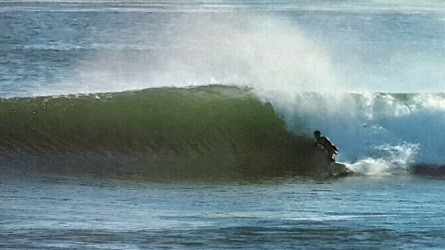 |
Here's the 'in-the-pocket' style of Australian 'Nat' Young, World Surfing Champion. Photos by John Witzig. |
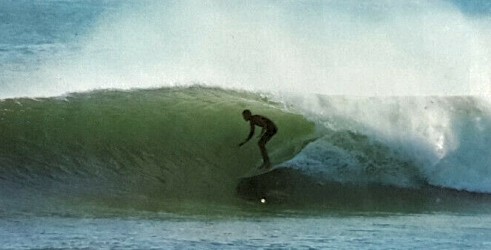 |
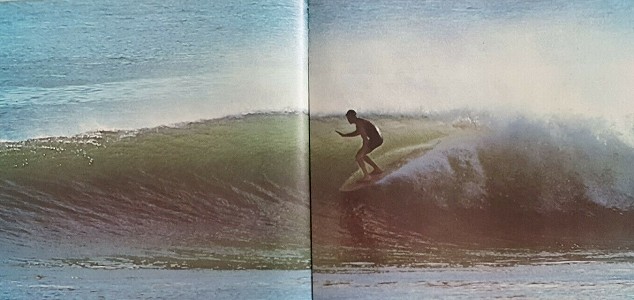 |
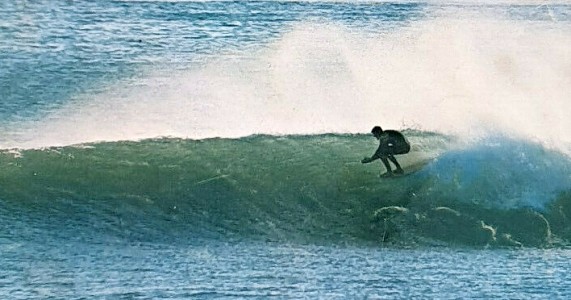 |
A contest
system should work to draw from the competing surfers their
best.
When the
surfers have to work for, to surf for, the system, then the
system has defeated its purpose.
The
Huntington contest is a prime example of a restricted wave
contest.
Through
Australian eyes this was the most tedious and uninteresting
contest that I have ever seen.
Even the
stupidity of the mass public enthusiasm for nose work did
little to arouse interest.
The surfers,
restricted and confined by the system, did not attempt
anything which would constitute a chance.
Indeed they
could not.
A contest
system must simulate as closely as possible, those
conditions that are experienced in the ocean.
If the
freedom that we find so inherent in riding waves is not
expressed in our competitions, then they are not true
contests of surfing.
If we are to
derive any value from contests then they should encourage
the surfer to draw on greater talents than he is aware he
possesses.
A surfer
must have that freedom that allows him to attempt far
greater things, and make a mistake in the process.
To my
knowledge achievement has never been laid at the door of the
ordinary person.
Consistency
becomes mediocrity unless measured in terms of challenge and
achievement.
The surfer
with whom Greenough first came into contact was Bob
McTavish.
A
theoretician in his own right, it was only reasonable that
he and Greenough might spur each other to greater levels of
creativity and experimentation.
McTavish and
Greenough talked and surfed, and began applying their
principles to surfboard design.
While
everyone else in Australia was turning to longer boards,
McTavish built short and more manoeuvreable boards which he
could use to place himself in the best part of the wave.
McTavish's
words best describe his principle motive:
"The
direction is involvement.
Getting into
tight spots and getting back out of them.
This is of
course, a supplement direction to the all powerful 'make the
wave' motive.
The way to
get involved, obviously, is to place yourself in a critical
position, under, in, over, around the curl, quite often in
contact with it."
The trend is
to push things to the limit:
"The tighter
you push them; the longer you hold them; the more involved
you are; the more situations you can overcome; the hotter
you are."
This then is
the McTavish philosophy.
The desire
to attempt the impossible; to transgress into the realm of
the unattainable; to power.
McTavish,
the master tactician of the perfect wave, saw his personal
limitations in the transference of his thoughts into general
surfing.
He chose
then to infuse with his enthusiasm and his aggression a
number of other surfers in Australia.
The result
of this union was the surfer that the world saw as the best
in San Diego.
Nat has an
enormous reservoir of surfing talent.
He has a
feeling for the surf that he can express in his riding.
He possesses
that superb control under all circumstances that mark him as
a fine surfer.
He is part
of this 'power' school of surfing: he
has crushed the 'pansy' surfers of California and the East
Coast: the mediocre 'competition surfers' have paled into
insignificance in the face of his aggression.
Nat is the
best surfer in Australia.
Australia is
represented by its best.
How is it
that the United States is not?
Of the ten
Californian surfers, only John Peck showed some sort of
aggression, and David Nuuhiwa showed that he was capable of
it.
While
Australia presented its finest, the U.S. had only its
run-of-the-mill ordinary, and its specialists.
Surfboards
expressed as clearly as any other factor, the extent of the
deviation in direction that has occurred in Californian
surfing.
There was
the ever present concave, the stretch, the 50 50, da cat,
the performer, the eliminator and the penetrator.
|
Page
52 It is the concern of this Australian surfer that. his board should express, as he himself sees it, the whole, rather than a series of unrelated or specialist manoeuvres. The Australian concern is with 'the whole' and the Australian board is designed with this purpose in mind. The direction is positive. It is towards dynamic and controlled aggression in surfing. What is the future? As I see it, a continued domination of world surfing by the Australians. Californian surfing is so tied and stifled by restrictions that are its own creation, and other countries simply do not have the necessary ability. What chance is there that California will free itself of its encumbrances? This is something that I cannot answer. General social conditions will continue to exercise an influence over the surfing scene. The drug situation is something which cannot be ignored.
|
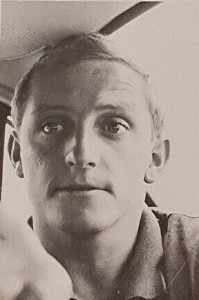 |
| Page 53 "Push
things to the limit- the
tighter you push them; the longer you hold
them; the more involved you are;
the more situations you can overcome; the hotter you are."- Bob McTavish. To the right, an example of Mctavish and his style. 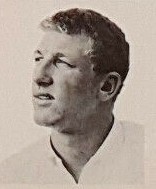 "Nat has crushed the 'pansy' surfers of California and the East Coast: The mediocre 'competition surfers' have paled into insignificance in the face of his aggression." |
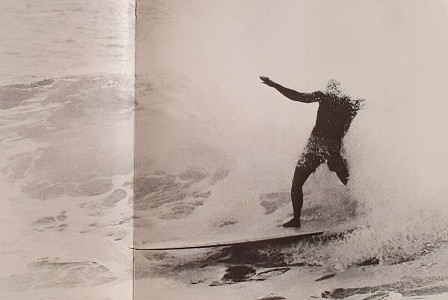 |
 Bob Cooper: Morey-Pope Blue Machine 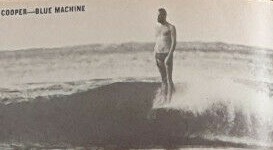 |
The
Men and Their Models
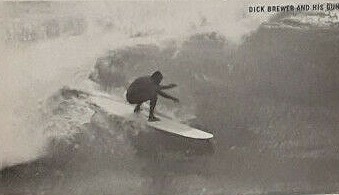 Dick Brewer: Gun by Bing Surfboards. Rider: Jock Sutherland |
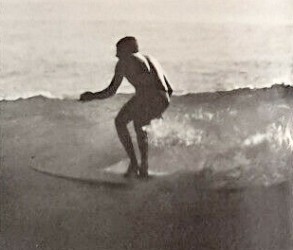 Micky Dora:
da cat by Greg Noll Surfboards |
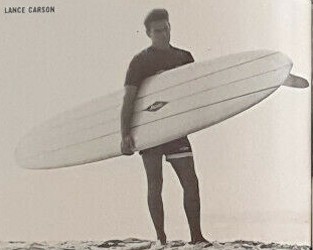 Lance Carson: Lance Carson model by Jacobs Surfboards |
| Page 32 |
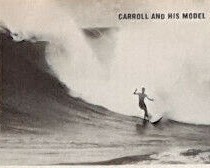 Corky Carroll:
da cat by Hobie Surfboards |
Mike Doyle:
Hansen Surfboards |
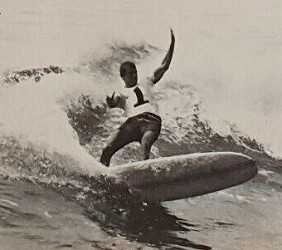 |

| home | catalogue | history | references | appendix |